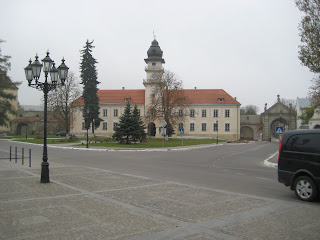In the afternoon, we headed to the town of Drohobych, which, compared to some of the other villages we saw, was more like a small city. It was built on a similar plan to L'viv, with a city hall building at the center of the market square. Here, though, some of the buildings around the perimeter of the square were rebuilt during Soviet time with particularly drab results.
 |
"Welcome to Drohobych"
 |
Market Square
 |
| City Hall |
|
 |
| The building on the right was once a synagogue, and now it's a boxing gym. |
 |
Sholom Aleichem Street.
 |
Street scene
 |
Placard honoring Ivan Franko, a famous Ukrainian writer from this area.
 |
Homeless dog
 |
Bustling street scene
 |
| Dad standing in front of a beautiful house. |
|
|
|
|
|
|
|
|
|
|
|
|
|
The main attraction, for us at least, was the enormous Choral Synagogue near the center of town, built in the 1860s. It's a hulk, completely gutted on the inside, but it's still standing. It was apparently used as a furniture store before being returned to the Jewish community. it is in the process of being restored, and people were working on the building. We were even able to go inside, which was really amazing to see, especially the faded Hebrew inscriptions still visible on the walls. I hope that during the restoration, someone will do research to analyze the walls and return them to their former condition. Interesting fact - because there was a height restriction, a lot of the synagogues in Galicia were built with the first floor below ground, so you enter down a set of stairs. That way, you could have the interior space as large as you wanted while still conforming to the height limits.
 |
| Synagogue exterior |
 |
| Interior w/ exposed support beam and another tour group - we were not the only visitors! |
 |
| vaulted ceiling |
 |
| Harold and Alex inside the synagoge |
 |
| wall inscriptions |
 |
| exterior close-up. |

















































